A Brief History of the Golf Ball
by Irena Kavas (author) Rachel Barton (co-author, editor) London, UK Published on 14go.9.2016 - Latest update 22.9.2016
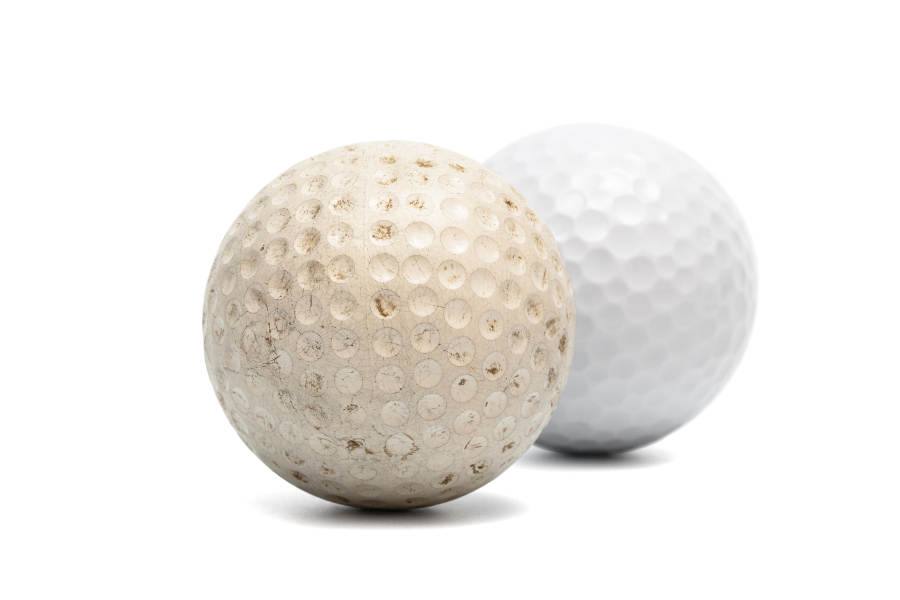
Table of Contents
- Introduction
- Mythical Origins of Golf Ball (and the Game of Golf)
- Featherie
- Gutta Percha Ball (The Guttie)
- Rubber-Wound Golf Ball
- Modern Golf Ball
- A Glance into the Future
- Footnotes
- References
Introduction to the history of golf balls
A golf ball is central to the game of golf. In fact, golf is all about the ball. Well, getting it into the hole in the ground. All the fuss surrounding the correct posture, swinging technique, proper grip, etc. is actually all about hitting the ball at the right angle, sending it the right distance and last but not least to control its direction, speed and rotation. And while most golfers are aware of the influence of golf clubs on their performance, only a few understand how the selection of the ball affects the game, or about the history of golf balls in general. And even fewer golfers know that the ball has been responsible for quite a few revolutions in golf. According to John F. Hotchkiss (1997), the author of one of the most acclaimed books on the history of the golf ball, the latter revolutionised the game at least four times.
Mythical origins of the golf ball (and the game of golf)
The popular story goes, that the first golf ball was a simple rounded stone that was hit by a bored shepherd using his crook. By pure luck, the stone ended up in a hole in the ground, encouraging the shepherd to repeat his "success" by trying to hit more stones in the hole. He found the newly invented game amusing and as he got better at it, he asked his friends to join him. And that's how golf is supposed to have been born. Unfortunately, there is no historical evidence for this story and we will probably never know who invented the game of golf and when golf was invented.
There is a general agreement that golf originates from medieval Scotland, but a game involving the use of a stick and ball predates the Middle Ages for several centuries. Some authors trace the origins of golf to the Roman stick and ball game called paganica which is believed to be played as early as the 1st century BC and may have been spread by the Romans to areas of Northern Europe including Britain. 1 2 But there is a problem with this version of the story as well. First, there is no written or pictorial evidence of paganica, so we don't really know whether this Roman game is the forerunner of the modern game of golf.3 According to some authors, it was probably more similar to hockey rather than golf.4
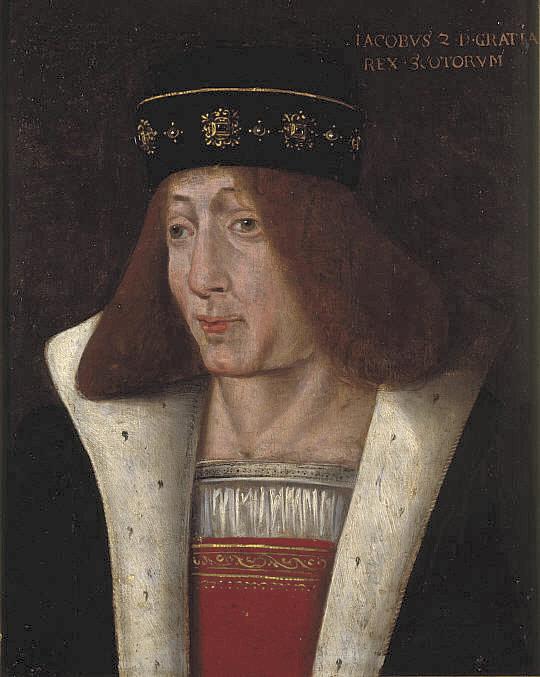
Photo credit: "King James II of Scotland" credit to National Galleries
A Dutch game known as kolven or kolf that was played with a stick and leather ball at least since the 13th century is by most authors seen as the most probable precursor of golf although there is also evidence of a similar game being played in China during the Song Dynasty (960-1279). 5 6 In addition, the claim to the "invention" of golf has also been laid by the French. This claim is largely based on a late 14th century illustration depicting two individuals playing a golf-like game. However, they could also be playing kolven or kolf.7 And then there is also the British game known as cambuca, which was played in the 14th century with a small wooden ball and a mallet.8 But as Hotchkiss notes, the game came to be called gowf, goff and eventually, golf only when the players started hitting the ball with an aim to get it into the hole in the ground. And by the time that happened, the game was very much established in Scotland.9
The idea for a golf-like game may have come from elsewhere but modern golf was born in Scotland. 10 By the mid-15th century, it became so popular that it had to be banned by the Act of Parliament in 1457 for interfering with archery practice which was seen vital for national defence.11 The ban, however, didn't work which clearly indicates the fact that it had to be repeated by the successors of King James II of Scotland (r. 1437-1460), James III (r. 1460-1488) and James IV (r. 1488-1513) in 1471 and 1491, respectively.12 Interestingly, the ban was ignored even by His Majesty James IV who is known to have been an enthusiastic golfer.13
The first golf ball in history was known as a Featherie
Information about the early history of golf balls is unfortunately very scarce. According to most authors who investigated the early history of golf ball, 14 15 16 17 the first balls (if we ignore the story about the shepherd and stones) were probably made of wood, most likely beech, boxroot and similar hardwoods. We know that the first record of a sold golf ball dates from 1452,18 while the first feather ball known as the featherie was introduced only in the early 17th century.
In 1618, a golf ball maker James Melvill from St. Andrews succeeded to get a 21-year monopoly from King James VI and I (r.1567-1625), granting him an exclusive right to make golf balls. Featheries which didn't include his bench mark were to be confiscated. At the same time, the King imposed an embargo on foreign feather balls. During the early "featherie era", the best balls were made by the Dutch and their featheries were extremely popular in Scotland as well.19
Until the mid-19th century, the featherie was the standard golf ball. It was made of cow or horsehide which was stuffed with feathers; most often goose feather. The leather, in order to be easier to work with, was soaked in water. The feathers that were forced into the ball by using a specially designed crutch-handled filling rod 20 were soaked as well. After the ball was carefully hand sewn together, it was left to dry. While the leather shrank, the feathers expanded, which made the ball very hard and compact21. Interestingly, the featherie also had excellent flight characteristics as it could reach a distance of up to 175 yards22; although the longest recorded distance is more than 361 yards.23 But it also had a quite a few weaknesses.
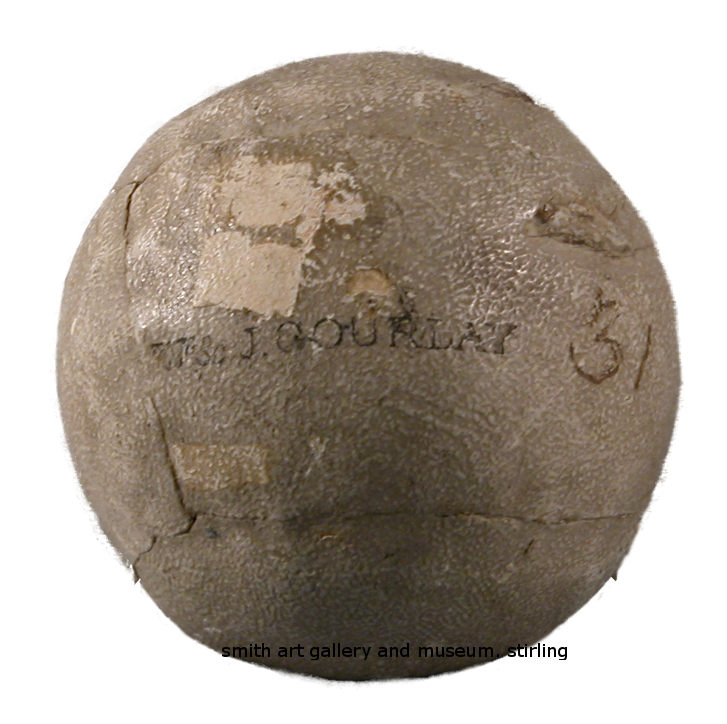
Photo Credit: "A Gourlay" to The Stirling Smith Art Gallery and Museum
Despite its outstanding flight characteristics, the featherie was more or less useless when it got wet. Ballmakers tried to "fix" the issue by rubbing it with neatsfoot oil and similar substances but this achieved only a limited success. 24 Also, the featherie could easily be cut if hit with an iron club at an awkward angle. Another major problem of the feather ball was the fact that the manufacturing process was very time-consuming and costly. Even the best ballmakers could make a maximum of four featheries a day. Unsurprisingly, this made them very expensive25; even more expensive than golf clubs. Also, the repeated pressure against the chest and inhalation of the feathers made stuffing and stitching of featheries a rather dangerous craft, as most ballmakers died at a young age.26 27
It remains unknown who succeeded James Melvill as the royal ballmaker after his 21-year long monopoly expired but the right to make golf balls was shortly thereafter also granted to John Dickson by the town council of Aberdeen. Their example was soon followed by other town councils, giving rise to several ball-making "dynasties": Robertsons, Hutchisons and Forgans, to mention only a few. However, the most desirable featheries were made by the Gourlays. Due to the superior quality, "a Gourlay" eventually came to be understood as a synonym for "the finest featherie money could buy." 28
By the end of the 18th century, the featherie became more or less standardised. It was on average 1 ½ inches in diameter and weighted about 1.4 ounces (39.7 grams) to 1.6 ounces (45.4 grams) which largely corresponds to the size and weight of a modern golf ball. It was typically also treated with chalk or some sort of white pigment to increase its visibility. However, even the best ballmakers of the time couldn't make it perfectly round. 29 They also put in a lot of effort into making it as smooth as possible, convincing themselves that it would make it fly further. But as it would later turn out, this had the opposite effect of that intended.
Gutta Percha Ball (The Guttie)
In the mid-19th century, most people could only dream of playing golf. There were at the time fewer than 20 golf clubs around the world, with just three being outside Scotland. But that was not the only thing that prevented most people from playing golf. The high cost of golf essentials, especially of golf balls, made the game pretty much inaccessible to ordinary people. 31 But that was soon about to change.
The invention of the golf ball that was about to trigger a revolution is traditionally attributed to the Scottish divinity student Robert Adam Paterson (1829-1904). Some authors, 32 however, have questioned the story about a poor golf enthusiast who is looking for ways to be able to enjoy the game, which would eventually lead to the invention of the gutta percha ball or the guttie.33 The widely accepted story goes, that one fine day in 1843, Paterson's father received a package that contained a statue of Vishnu which was protected by shavings of gutta percha. Young Paterson played with the blackish-brown material of same name Malaya tree until he one day rolled it into a ball. It didn't take long for him to find it a purpose. He painted it white and tried it out in the herbage of the St. Andrews Old Course. After a few strokes, however, Paterson's gutta percha ball fell apart. Not willing to give up just yet, he made more balls and tried again. But the balls disintegrated very quickly this time as well.34
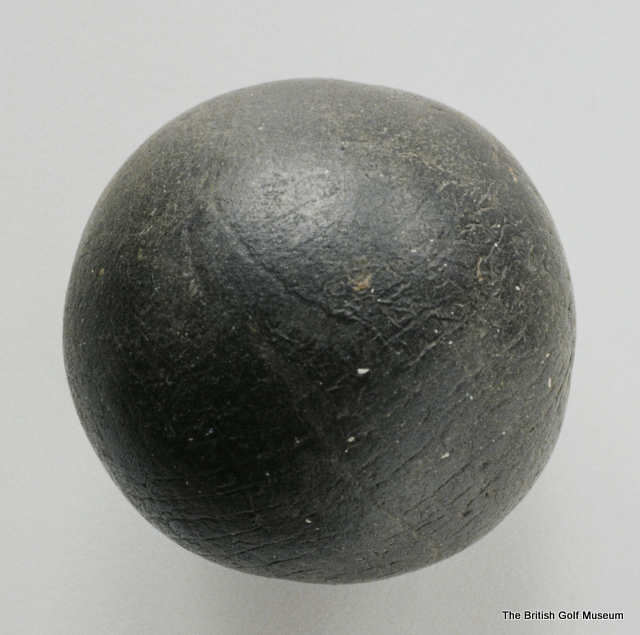
Photo Credit: "Gutta Percha (Smooth)" to The British Golf Museum
When young Paterson completed his studies, he emigrated to America. But before he left, he told his brother about his gutta percha "experiment" who thought it was worth giving it another try. And he did. In 1846, he sent the improved version in London but there was almost no interest in the novel golf ball. Little by little, however, the guttie was taken up by a growing number of golfers and by the early 1860s, the featherie practically became "extinct". 35
There are several reasons why the gutta percha ball replaced the featherie which was the standard for more than 300 years. Cheaper production and consequently, lower cost (up to 80 per cent!) are definitely among the main reasons for the success of the guttie. 36 Equally important, its performance wasn't in any way inferior to that of the featherie. In fact, it could fly even further than its costly counterpart, reaching distances of up to 246 yards. Also, it lasted longer and was less vulnerable to moisture, which was a huge advantage over the featherie, especially in the wet British climate.37 For obvious reasons, the old ballmaking "dynasties" initially resisted the change but when they realised the effect it had on the game and that the decrease of profits due to the lower cost of the guttie can be compensated by increased production, they accepted the new reality.38 Even the guttie's fiercest opponent, Allan Robertson of St. Andrews (1815-1859) changed his viewpoint when he figured out that he could make as many gutties in an hour as he could make featheries in an entire day.39
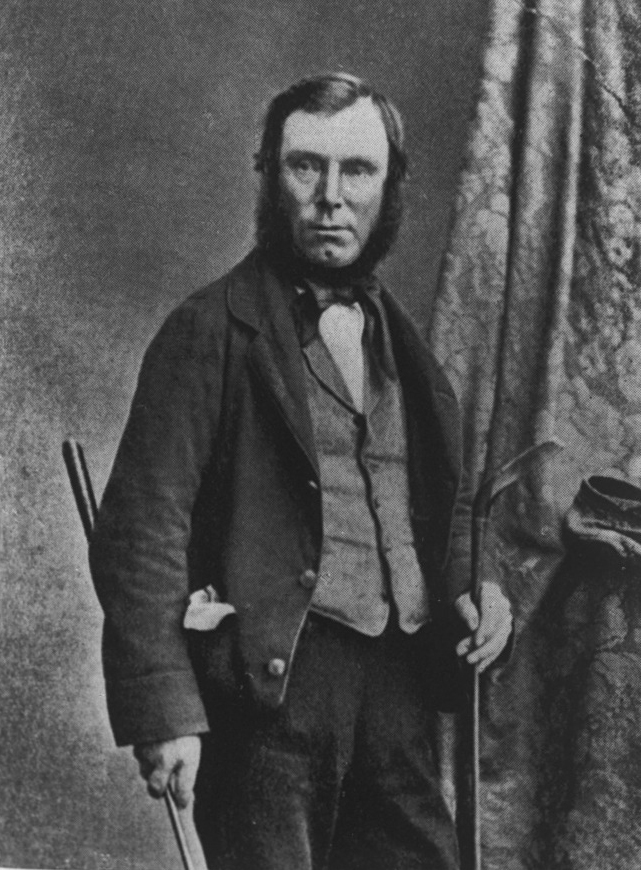
Photo Credit: "Allan Robertson" to World Golf Hall of Fame and Museum
The guttie sparked a revolution in golf. By making the game more affordable, especially after the mechanisation of its manufacture in the early 1870s 40, the guttie transformed golf from a sport of the elites to the sport of the masses. Golf suddenly became extremely affordable not just for tradesmen and artisans but even for college students. The increased interest in the game led to the development of new golf courses, creation of new golf clubs and an increased production of golf balls as well as other pieces of equipment in order to meet the growing demand.41 And what is perhaps even more important, the guttie helped transform golf from a British leisure activity to an international sport.42
It wasn't just the low cost of the guttie that triggered the "golf boom" in the second half of the 19th century. The new golf ball also made it easier to learn to play the game 43. In addition to flying further than the featherie, the guttie was also easier to control both in the air and on the green.44 However, the guttie had its disadvantages as well. Compared to the featherie, it was considerably more durable but according to today's standards, it still disintegrated relatively fast.45 And whilst being resistant to moisture, it wasn't resistant to cold weather. In low temperatures, it fell apart very easily. Likewise, it didn't perform well in extremely high temperatures and when compared to the featherie, the guttie didn’t only felt harsh and rigid, it also sounded harsh when hit with a club.46 Despite its "flaws", the guttie was the ball of choice from the mid-19th to the early 20th century around the world.
Rubber-Wound Golf Ball
On 11th April 1899, the American businessman and inventor Coburn Haskell (1868-1922) got a (joint) patent from the United States Patent Office for the rubber-wound ball 47 which would soon lead to another revolution in golf. Widely regarded as the first modern golf ball, Haskell's ball was made of a solid rubber-wound core that was covered by guttapercha. But the thing that ensured it made it to become the next ball of choice was its performance; bringing control and feel to a whole new level. In addition, it was exceptionally forgiving to mishits48 and flew over 20 yards further than the 100% gutta percha ball. When ballmakers adopted the dimple pattern (golf ball pattern featuring indentations or depressions on the surface), which was patented by the Englishman William Taylor in 190849, the rubberwound ball achieved even greater distances.50
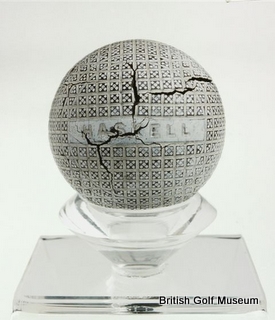
Photo Credit: "Haskell Golf Ball" to The British Golf Museum
Just like the invention of the gutta percha ball, the invention of the rubber-wound golf ball is kind of romanticised. 51 The narrative goes that Haskell, while waiting to be received by Bertram Work at the Goodrich plant, started playing with a bit of rubber thread. He rolled it into a ball and bounced it to the floor. To his surprise, the ball bounced back all the way to the ceiling. Haskell shared his "discovery" with Work and that is how the idea of a rubber-wound golf ball was born. When it comes to the most commonly accepted story anyway because according to Hotchkiss, there are at least four different versions of Haskell's ground-breaking invention.53
In 1901, Haskell founded the Haskell Golf Ball Company and launched the manufacture of the rubberwound ball. Later that year, his ball "helped" Walter Travis (1861-1927) win the U.S. Amateur and become the first golf player to win a Major using the novel golf ball. Haskell's ball was also taken up by Sandy Herd (1868-1944) and Laurie Auchterlonie (1867-1948), the winner of the 1902 Open Championship and 1902 U.S. Open, respectively, which convinced most of their fellow players to follow their example. 54 Except for the British who found the Haskell ball "unsporting".55 The British had a point when it comes to several things, however, a new revolution was already on the way and it could no longer be halted. But there was still plenty of room left for improvement which is exactly what the leading ballmakers were trying to do over the next decades.56
The dimple pattern was the first major improvement of the Haskell, and a big step in the history of golf balls and their design. Compared to the previously dominating bramble pattern (golf ball pattern featuring pimples or brambles), golf balls with the 1908- patented Taylor dimple pattern flew much further. With the exception of a few "experiment" mesh and lattice patterns, all golf balls had the exact same dimple pattern known as the Atti Pattern until the early 1970s. Only then the ballmakers started to question the aerodynamics of Ralph Atti's octahedron dimples covering 66 percent of the ball. 57 In the meanwhile, the majority of golf ball manufacturers rather focused on finding the perfect core.
In the same year when Taylor was granted the patent for the dimple pattern, the Scottish inventor Frank H. Mingay was granted the patent for a liquid core golf ball by the United States Patent Office. 58 The leading ballmakers of the time including Spalding liked the idea of a liquid-core ball and for much of the 20th century, they were preoccupied with finding the perfect material/substance for "a solid although mobile core" 59; although some also experimented with solid materials.60 Almost nothing was off limits as the list of materials they experimented with also included things such as castor oil, mercury, honey and even wine. In 1910, Haskell's friend and golfing companion George Worthington created and patented what he called the Radio ball. Its name was inspired by its "magic" ingredient which was believe it or not, radium.61
There was obviously nothing magical about radium. Other materials that were experimented with didn't make much difference either. Thus the quest for the perfect core material continued throughout much of the rest of the history of golf balls. Meanwhile, Haskell sold both his company and patent to the Spalding Company and retired as a very wealthy man. 62
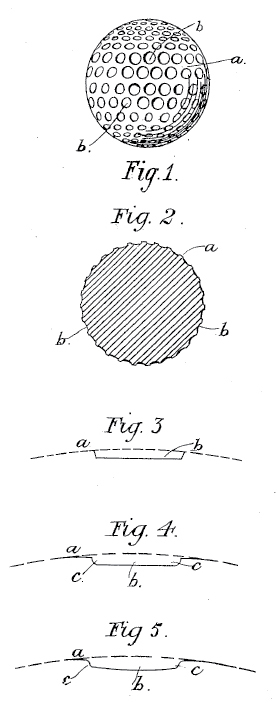
William Taylor-Patented "Dimple Pattern" (United States Patent Office)
Modern Golf Ball
Even though the Haskell's rubber-wound core ball is traditionally regarded as the first modern golf ball, the origins of the ball that is used by today's pros and amateurs alike dates from the 1960s. At that time, an American chemical engineer named James R. Bartsch (1933-1991) entered the golf ballmaking business only to find out that he was not going to succeed unless he finds a way to reduce the cost of the materials and labour. He started to experiment with various synthetic materials and refused to give up until he found the perfect formula. Bartsch's ball, however, wasn't only more than twice less expensive to produce 63 but it also re-introduced the concept of a solid-moulded ball.
In 1963, Bartsch filled for a patent, but by the time he finally got it in 1967 64, Spalding had a one-piece ball of its own - the Unicore. Shortly thereafter, Spalding also launched the Executive. Besides becoming the first one-piece ball since the guttie, Spalding's one-piece ball was also superior to the Bartsch's counterpart. In the same year, Ram launched the first golf ball featuring DuPont-produced Surlyn ionomer resin cover which would eventually became the most popular golf ball cover.65 All, however, only helped set the stage for a truly revolutionary golf ball that was introduced by Spalding in 1972: the two-piece Top-Flite which, as Hotchkiss noted, 66 turned out to be the golf ball of the future.
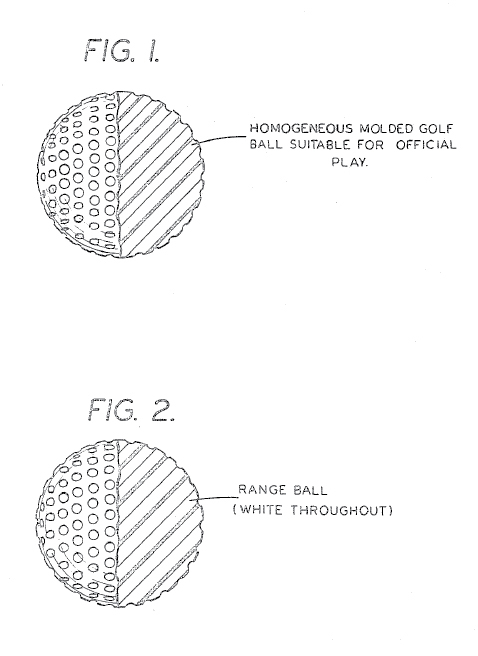
"Bartsch Golf Ball" (United States Patent Office)
Featuring the Surlyn cover, the Top Flite wasn't only incomparably more durable than the Bartsch's single-piece ball but it also addressed every golfer's dream: distance. Its overall performance, however, wasn't on par with that of the balatawound rubber core and therefore, most professionals refused to switch to the novel ball. 67 This would change only after Tiger Woods won The 2000 Open Championship playing with Nike solid construction ball called the Tour Accuracy.68 In the very same year, Titleist also launched the ProV1 three-piece multilayer ball which became an instant success. As soon as it was introduced to the Tour in Las Vegas in October 2000, as many as 47 pros decided to switch to the ProV169. And it didn't take long for amateurs to follow in their footsteps.
The golf ball market continues to be dominated by the Titleist ProV1 and Titleist four-piece version ProV1x golf balls, which made their manufacturer an absolute winner of the 1990s "Golf Ball War".70 However, Titleist's over 15-year old "reign" didn't scare away other ballmakers. Golfers can thus today choose from more than 1,000 golf balls (excluding those that are not on the USGA and R&A Conforming Ball List)71 designed to provide more control, achieve greater distances, increased durability, optimal spin, etc. and ultimately, make the game more enjoyable while helping golfers improve their score.
A Glance into the Future
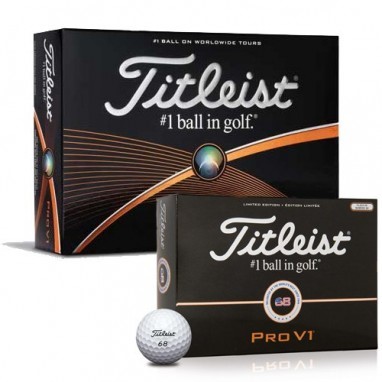
Photo Credit: "Titleist ProV1" listed on Golf Support
You probably have a good understanding of the history of golf balls by now, so it may be interesting to take a glance into the future too. Considering the domination of the Titleist Pro V1 and V1x over the last 15 years, it has become hard to imagine other brands dominating the market; not any time soon, anyway. But we mustn't forget that domination of this kind is not new in the world of golf balls. Across the history of golf balls, and especially during the era of the featheries, ballmaking was in the domain of only a few families for generations. And when the guttie hit the market, they simply switched to making the gutta percha. But after F1the mechanisation of the guttie manufacture, large rubber companies joined the ballmaking industry and slowly took over the dominating position of the former ballmaking "dynasties". But for the end user - the golfer, the essence remained unchanged. He or she could choose between golf balls from a handful of major brands which didn't really have any serious competition for much of the 20th century.
Last but not the least important, we mustn't forget the fact that golf is a game that keeps on growing and evolving. And with it, golf essentials- including the golf ball - continues to evolve as well. Maybe another major revolution may already be on its way, but we just don't know it yet.
Footnotes
(1) Malcolm Campbell and Glyn Satterley, The Scottish Golf Book (Champaign: Lomond Books, 2002), 14.
(2) Bill Mallon and Randon Jerris, Historical Dictionary of Golf (Lanham: Scarecrow Press, 2011), 217.
(3) John F. Hotchkiss, 500 Years of Golf Balls: History & Collector's Guide (Iowa: Antique Trader Books, 1997), 12.
(5) David Arscott Golf, A Very Peculiar History (Brighton: Book House, 2010), 11.
(12) "Acts of Parliament banning golf", National Library of Scotland, accessed August 3, 2016. http://digital.nls.uk/golf-in-scotland/banned/1457-act.html.
(13) "The Royal and Ancient Game", British Golf Museum, accessed August 3, 2016. http://www.britishgolfmuseum.co.uk/the-collections/the-royal-and-ancient-game/.
(16) Colin White, Projectile Dynamics in Sport: Principles and Applications (Abingdon: Routledge, 2011), 187.
(17) Paul Donnelley, Firsts, Lasts & Onlys of Golf: Presenting the most amazing golf facts from the last 600 years (London: Hamlyn, 2010), Kindle Edition.
(31) DK, The Golf Book (London: DK, 2008), 19.
(32) Harry Brown, Golf Ball (New York: Bloomsbury Academic, London 2015), 19.
(33) Golf Ball Inventor Dead, The New York Times, accessed August 3, 2016, http://query.nytimes.com/mem/archive-free/pdf?_r=1&res=9C02E4DA1E3BE631A25755C2A9629C946597D6CF.
(45) Leon Z. Seltzer, Golf: The Science and Art (Mustang: Tate Publishing & Enterprises, 2007), 38.
(47) Bertram G. Work, and Coburn Haskell, "Ball," U.S. Patent 622,834 filed August 9, 1898, and issued April 11, 1899.
(48) Tim Harris, "Coburn Haskell" in Players: 250 Men, Women and Animals Who Created Modern Sport (London: Yellow Jersey, 2009), Kindle Edition.
(49) William Taylor, "Golf Ball," U.S. Patent 878,254 filed September 11, 1906, and issued February 1908.
(52) Harris, Players: 250 Men, Women and Animals.
(54) Donnelley, Firsts, Lasts & Onlys of Golf.
(58) Frank H. Mingay, "Golf Ball," U.S. Patent 889,709 filed April 7, 1908, and issued June 2, 1908.
(62) Harris, Players: 250 Men, Women and Animals.
(64) James R. Bartsch, "Unitary Molded Golf Ball," U.S. Patent 3,313,545 filed September 12, 1963, and issued April 11, 1967.
(68) "Tiger Woods gives his insight on golf equipment", Golfweek, last modified August 20, 2014. http://golfweek.com/2014/08/20/tiger-woods-golf-equipment-nike-golf-irons/.
(69) Jonathan Wall, "The evolution of Titleist's Pro V1," PGA Tour, last modified September 6, 2013. http://www.pgatour.com/news/2013/09/06/the-evolution-of-the-pro-v1.html.
(70) John Holmes, "New crop of golf balls blossoms in year without ProV1 launch" PGA http://www.pga.com/golf-equipment/golf-buzz/new-crop-golf-balls-blossoms-in-year-without-prov1-launch.
(71) "Conforming Golf List USGA", USGA, accessed August 4, 2016. http://www.usga.org/ConformingGolfBall/conforming_golf_ball.asp.
References
"Acts of Parliament banning golf." National Library of Scotland. Accessed August 3, 2016. http://digital.nls.uk/golf-in-scotland/banned/1457-act.html.
"A Gourlay." Photograph. Source: The Stirling Smith Art Gallery and Museum. http://www.smithartgalleryandmuseum.co.uk/.
"Allan Robertson." Photograph. Source: World Golf of Fame & Museum. http://www.worldgolfhalloffame.org/.
Arscott, David. Golf, A Very Peculiar History. Brighton: Book House, 2010.
Bartsch, James R. "Unitary Molded Golf Ball." U.S. Patent 3,313,545 filed September 12, 1963, and issued April 11, 1967.
"Bartsch Golf Ball." Illustration. Source: United States Patent Office. Available from https://docs.google.com/viewer?url=patentimages.storage.googleapis.com/pdfs/US3313545.pdf.
Campbell, Malcolm and Glyn Satterley. The Scottish Golf Book. Champaign: Lomond Books, 2002.
"Conforming Golf List USGA." USGA. Accessed August 4, 2016. http://www.usga.org/ConformingGolfBall/conforming_golf_ball.asp.
"Dimple Pattern." Illustration. Source: United States Patent Office. Available from https://docs.google.com/viewer?url=patentimages.storage.googleapis.com/pdfs/US878254.pdf .
DK. The Golf Book. London: DK, 2008.
Donnelley, Paul. Firsts, Lasts & Onlys of Golf: Presenting the most amazing golf facts from the last 600 years . London: Hamlyn, 2010.
"Golf Ball Inventor Dead." The New York Times. Accessed August 3, 2016. http://query.nytimes.com/mem/archive-free/pdf?_r=1&res=9C02E4DA1E3BE631A25755C2A9629C946597D6CF.
"Gutta Percha (Smooth)." Photograph. Source: The British Golf Museum. http://www.britishgolfmuseum.co.uk/.
Harris, Tim. "Coburn Haskell" in Players: 250 Men, Women and Animals Who Created Modern Sport, Coburn Haskell. London: Yellow Jersey, 2009.
"Haskell Golf Ball." Photograph. Source: The British Golf Museum. http://www.britishgolfmuseum.co.uk/.
Holmes, John. "New crop of golf balls blossoms in year without ProV1 launch." PGA. Last modified January 27, 2016. http://www.pga.com/golf-equipment/golf-buzz/new-crop-golf-ballsblossoms-in-year-without-prov1-launch.
Hotchkiss, John F. 500 Years of Golf Balls: History & Collector's Guide. Iowa: Antique Trader Books, 1997.
Mallon, Bill and Randon Jerris. Historical Dictionary of Golf. Lanham: Scarecrow Press, 2011.
Mingay, Frank H. "Golf Ball." U.S. Patent 889,709 filed April 7, 1908, and issued June 2, 1908.
Seltzer, Leon Z. Golf: The Science and Art. Mustang: Tate Publishing & Enterprises, 2007.
Taylor, William. "Golf Ball." U.S. Patent 878,254 filed September 11, 1906, and issued February 1908.
"The Royal and Ancient Game." British Golf Museum. Accessed August 3, 2016. http://www.britishgolfmuseum.co.uk/the-collections/the-royal-and-ancient-game.
"Tiger Woods gives his insight on golf equipment." Golfweek. Last modified August 20, 2014. http://golfweek.com/2014/08/20/tiger-woods-golf-equipment-nike-golf-irons/.
"Titleist ProV1." Photograph. Source. GolfSupport. https://golfsupport.com/.
Wall, Jonathan. "The evolution of Titleist's Pro V1." PGA Tour. Last modified September 6, 2013. http://www.pgatour.com/news/2013/09/06/the-evolution-of-the-pro-v1.html.
White, Colin. Projectile Dynamics in Sport: Principles and Applications. Abingdon: Routledge, 2011.
Work, Bertram G., and Coburn Haskell. "Ball." U.S. Patent 622,834, filed August 9, 1898, and issued April 11, 1899.









